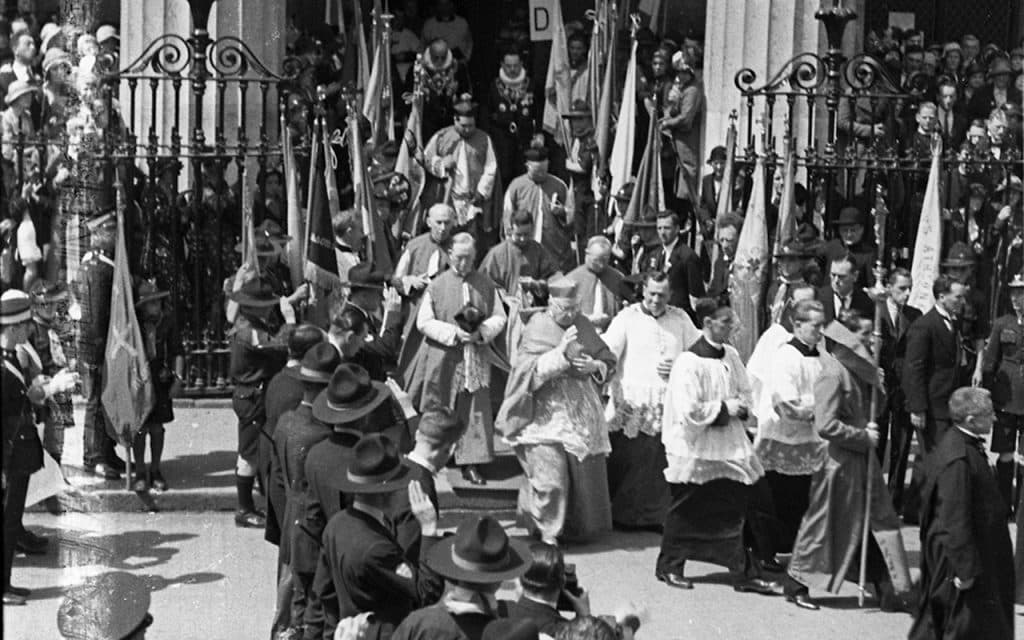Myself and my friends have this phrase we use on the occasions we meet up and start reminiscing on our youth. We tend to say, we grew up in an era with one foot in ‘old’ Ireland and another in the ‘new’. We were from a generation where childhood was more innocent, simpler, wholly un-materialistic, conservative, religious. By the time I got to college (which was only then beginning to become more mainstream), new Ireland was creeping slowly onto the scene. Divorce became legal; homosexuality was decriminalised; we elected a female president for the first time; Magdalen laundries/mother and baby homes were being shut down (not that I had ever heard that phrase as a child); people were starting to emigrate for choice or adventure rather than for necessity or shame. The new world came hard and fast soon after that. Humanity has not experienced such an accelerated leap forward since probably around the turn of the 19th century, with the revolution from horses to cars, and hot air balloons to airplanes.
There are those who can make cases that the model of religious morality we fostered since the foundation of the State was suffocating, hypocritical and to many, damaging. Others voice concerns over society’s lack of values, higher levels of violence and homage to all things materialistic. Is that a result of the decline of the dominant role of the Catholic Church or is it that our world would have inevitably been challenged by the problems that we face today, because of this explosive leap forward we have witnessed in the 21st century? I guess your perspective will probably be shaped by where you stand on religion, but I think it’s fair to say we had a lot wrong with our ‘old’ Ireland, and there’s plenty wrong with the ‘new ‘one too.
Let me take you back nearly one hundred years, to a landscape that would be unrecognisable today. To a place where the Catholic Church was the dominate force, and to a religious event that would go on to define Irish culture and society – the 1932 Eucharistic Congress. This event was staged in different locations around the world, since its inception 1881. In 1932, on the 1,500-year anniversary of the arrival of Saint Patrick, the Congress was awarded to Ireland, as a way of recognising Ireland’s dedication to the Christian faith. Pope Pius XI sent his papal legate, Cardinal Lauri to represent him in Dublin. The opportunities afforded by the granting of the congress were huge. It would help position the independence of the Free State on a global stage, and reinforce its cultural differences from Britain. This was not the first time that the new Irish Free State had looked to promote its cultural differences that were once shackled by imperialism. In 1924, the ancient Irish tradition, the Tailteann Games, was revived by the Cumann na nGaedheal government. The events held in Croke Park were attended by an impressive 250,000 people. (It was also successful in 1928 but by ’32 was losing popular and political support.) But these games were to be dwarfed eight years later when an estimated 1.5 million attended the Eucharistic Congress that celebrated, not sport, but Catholicism.
For five days, between June 22 and June 26, the Catholics of Ireland came in their droves to Dublin, including pilgrims from the north who incidentally were stoned by protestant loyalists lying in wait. The celebrations began with 50,000 people amassing on the piers and roads of Dun Laoghaire, simply to herald in the arrive of the Papal legate. More celebrious figures, such as Arch Bishop Byrne and Taoiseach Eamon De Valera, welcomed him personally.

“The Schools’ Collection, Volume 0621, Page 413” by Dúchas © National Folklore Collection, UCD
The streets were festooned in the white and yellow of the papal colours, from the broadest grand streets and squares of Dublin to the tiny slum lanes and less well-to-do corners. There was very much an inclusive feel to the proceedings according to witness testimonies of the time. Its high point was of course the procession through Dublin, surrounded by hordes of people and the open air mass in Phoenix Park that was attended by an estimated one million souls, (only to be eclipsed by the open air mass for Pope John Paul in the same venue in 1979. Though one has to consider, if a million went to see the Pope’s legate, what would the turnout have been if Pope Pius had come himself?) De Valera, when he spoke, was at pains to emphasise the freedom of the Irish Catholic in the Free State compared to their treatment under centuries of British rule.
But what were the consequences of the Congress on shaping Irish society? At the time, it was a proud moment for the country when Irishness, nationalism and Catholicism was synonymous with each other. That in itself would become problematic, for many were neither Catholic nor nationalist. Schools were closed, as were offices. Government business was suspended and universities shut. In the short term, there was some financial relief to the Irish economy given that the ‘economic war’ between Ireland and Britain was starting. It also demonstrated that despite the destructive nature of the civil war only a decade earlier, Irish people could unite and celebrate under the one banner – Catholicism. This was hugely symbolised by the peaceful transfer of power from Cumann na nGaedheal to Fianna Fail in March 1932. Despite the event being organised by Cosgrave, his defeat in the election had meant his arch-rival and political nemesis Dev, was going to be the face of this historical event.
Any analysis of this period must not be judged by today’s standards, nor can historians always look back and say one event, ‘inevitably’ led to the next. The values of people then were very different than they are today and people did embrace the proceedings of ‘32. But could it be argued that the Eucharist Congress set the tone for church interference in areas it should not have gone? Part of Ireland’s rebranding after centuries of imperialism, was the promotion of the GAA and the Irish language. The Church, emboldened by the success of the Congress, and the willingness of politicians to facilitate it, would become the third leg of that stool. It would accelerate exponentially in a few short years. The placing of the Catholic Church’s privileged position in Irish society, into the constitution of 1937, under the heavy influence of De Valera, gave it untouchable powers that would cause problems later.
While the Church for years had dominant numbers in occupations such as teaching and nursing, Catholic dogma soon became enshrined into the fabric of society and its institutions. Their untouchable powers in schools meant that the abuse of children in regular or industrial schools would for generations go unpunished. We now know, that internal investigations by the Church would often result in moving the abuser to another parish, rather than make it public or fire the perpetrators. [Even more startling was that oftentimes Gardaí would defer to a bishop when faced with a complaint of a sexual nature]. The role of the Church in healthcare would have detrimental effect on women in particular. Dr Noel Browne, who did so much in his role as Minister of Health, to tackle the scourge of TB, through his interventions, was much maligned and eventually beaten by the Church when he tried to introduce family planning and contraception in the 1950s. It was a time of great poverty and mass unemployment. Having smaller families would have permitted families to cope better and recognise women as more than just bearers of children. It never happened because of Archbishop Charles McQuaid’s direct influence in preventing Browne’s proposal for seeing the light of day. The over-moralisation of society, facilitated and nurtured by the Church meant that generations of Irish women were incarcerated into mother and baby home when they had a child out of wedlock. Thousands of babies were illegally taken from the mothers, and many hundreds died from neglect. Many more have since been discovered discarded in septic tanks and unmarked graves.
The Eucharistic Congress helped facilitate the Church into a dominant cultural force, supported by the people, and politicians, lest we not forget. It permeated into areas of life that it should never have touched. It meant Ireland faltered as a progressive society on many levels. Critical debate was curtailed, and censorship, as well as Catholic influence on the media and television, would prevail. It would take the revelations of abuse in the 1990s to unleash a fury and ‘memory’ that found voice, and eventually courage, to tackle the imbalance that had taken hold of Ireland. Within a decade, eighty years of unquestionable power came tumbling down. For many it was justified, others felt its vacuum. Though 69 per cent of Irish people still ticked the Catholic ‘box’ in the census (2022), it’s not the same type of all-encompassing Catholicism of the 1930s. There are many forces that drive today’s violence and immorality, such as drugs, the internet, polarisation, pornography. For many others, it may be that the guiding hand of religion has been chopped off. For all that’s said and done, we certainly live in a freer society today.



